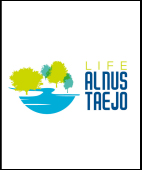
LIFE Project: Conservation and restoration of priority habitat of Mediterranean alder forests in the western international basin of the Tagus River
- Type Project
- Status In progress
- Execution 2021 -2026
- Assigned Budget 3.987.639,00 €
- Scope Europeo
- Autonomous community Madrid, Comunidad de
- Main source of financing LIFE
- Project website Web del proyecto
The LIFE ALNUS TAEJO project aims to protect, conserve, enhance, and restore rivers and riverbanks dominated by residual alluvial forests (priority habitat type 91E0*), which are home to a high level of biodiversity and influence the quality of river waters and their ecosystems.
The Mediterranean region is one of the most vulnerable areas in the world to the effects of climate change, including flooding and soil erosion. Mediterranean alluvial forests, a priority habitat for the Habitats Directive (91E0* 'Alluvial forests with Alnus glutinosa and Fraxinus excelsior (Alno-Padion, Alnion incanae, Salicion albae)', play an important role in stabilizing river banks. The alder grove ( Alnus glutinosa ) also improves the nutrient balance in the soil, useful for colonizing degraded areas. Mediterranean alluvial forests improve water quality, reduce eutrophication and are habitat for several species of Community interest, such as trout, otter and Iberian desman.
This valuable ecological and hydrological habitat in the western Tagus River basin is seriously threatened, and in large stretches of historical presence, it is already nonexistent. The ultimate goal of the project is to increase the area of alluvial forests in the Tagus River by 1,032 ha (516 km of streams), a habitat that currently represents only 14% of the river basin's length. The project focuses on the SCI of the Tagus River Basin. The main threat is the severe degradation and loss of water, soil, space, and biodiversity.
- Work with public administrations and relevant stakeholders to improve the management of hydrological ecosystems.
- Improve the structure and plant condition of 91E0* species (e.g., Alnus glutinosa, Frangula alnus, Fraxinus angustifolia, Salix atrocinerea).
- Recover soil and river spaces, promoting connectivity between the basin's ecosystems and restoring degraded areas.
- Reduce agricultural pressure on river banks;
Raise awareness among citizens about river ecosystems. - Reduce pollution and social and urban pressure on riverine forests.
- Improve water quality and river flows by better structuring them, eliminating illegal barriers, and halting illegal water extraction.
- Improve adaptation to climate change to help prevent droughts and desertification.
- Reduce the number and spread of invasive species.
Controlling Phytophthora alni, an alder disease. - Promote scientific and technical administrative networks to advance the replicability of these approaches in other watersheds and ecosystems.
- Floodwater forest habitat (91E0*): 432 ha (216 km) of direct river restoration and 600 ha (300 km) of natural river regeneration to promote connectivity.
- Improving the management of hydrological ecosystems.
- Increase in the area of alder forests and improvement of hydrological permeability in at least 320 ha of river banks.
- Increased plant biodiversity along 150 km of river banks.
- Reduction of agricultural pressure and recovery of river space in 30 ha.
- Soil restoration on eroded surfaces in 18 ha of river corridors.
- Improved river flow through action against illegal barriers and intakes, reducing longitudinal fragmentation and water runoff in 30 km of river.
- Improving water quality and reducing river pollution, as well as improving the ecological and hydromorphological structure along 45 km of rivers.
- Adaptation to climate change, drought prevention in 50 km of rivers, and management of flows linked to climate change.
- Control of Phytophthora alni on 30 km of riverbanks.
- Restoration of an urban river along 3 km.
- Reduction of pollution, social pressure, and urban pressure on rural and urban riverine forests along 15 km of urban rivers. Reclamation of riverine space along 3 km of riverbanks used as natural pools.
- Reduction of invasive plant species along 30 km of rivers.
- Awareness and environmental education on riparian ecosystems, reaching 1,500 people.
- Raising awareness among managers about the benefits of the basin-level approach (6 municipalities, 4 agricultural associations).
- Promotion of scientific, technical, and administrative networks for replication in Spain and other EU countries (6 administrations, 6 companies, 6 universities).
- Land stewardship agreements for the protection of river ecosystems with farmers.
- Coordinator/entity name: José Luis García Rodríguez
Postal address: Avenida Ramiro de Maeztu, 7, 28040, Madrid,
The project is in line with the EU Water Framework Directive, the Habitats Directive, the Birds Directive, the 2030 Biodiversity Strategy, the Floods Directive, and Directive 2004/17/EC on public procurement for entities operating in the water, energy, transport, and postal services sectors.
- UNIVERSIDAD POLITéCNICA DE MADRID
- ECOSALIX(Sistemas Ecológicos de Engenharia Natural, Lda)
- UEvora(UNIVERSIDADE DE EVORA)
- CTAEX(CENTRO TECNOLOGICO NACIONAL AGROALIMENTARIO EXTREMADURA)
- AMBIENTA(AMBIENTA INGENIERíA Y SERVICIOS AGRARIOS Y FORESTALES S.L.U.)
- CESEFOR(FUNDACIóN CENTRO DE SERVICIOS Y PROMOCION FORESTAL Y DE SU INDUSTRIA DE CASTILLA Y LEON)







